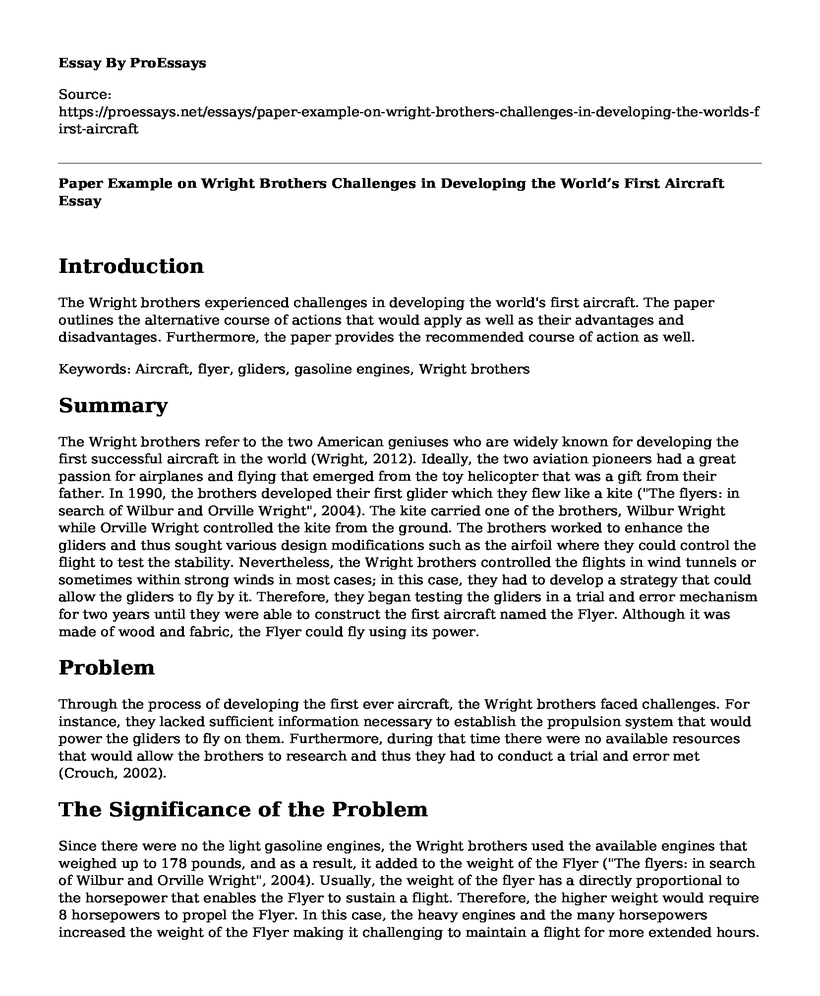Introduction
The Wright brothers experienced challenges in developing the world's first aircraft. The paper outlines the alternative course of actions that would apply as well as their advantages and disadvantages. Furthermore, the paper provides the recommended course of action as well.
Keywords: Aircraft, flyer, gliders, gasoline engines, Wright brothers
Summary
The Wright brothers refer to the two American geniuses who are widely known for developing the first successful aircraft in the world (Wright, 2012). Ideally, the two aviation pioneers had a great passion for airplanes and flying that emerged from the toy helicopter that was a gift from their father. In 1990, the brothers developed their first glider which they flew like a kite ("The flyers: in search of Wilbur and Orville Wright", 2004). The kite carried one of the brothers, Wilbur Wright while Orville Wright controlled the kite from the ground. The brothers worked to enhance the gliders and thus sought various design modifications such as the airfoil where they could control the flight to test the stability. Nevertheless, the Wright brothers controlled the flights in wind tunnels or sometimes within strong winds in most cases; in this case, they had to develop a strategy that could allow the gliders to fly by it. Therefore, they began testing the gliders in a trial and error mechanism for two years until they were able to construct the first aircraft named the Flyer. Although it was made of wood and fabric, the Flyer could fly using its power.
Problem
Through the process of developing the first ever aircraft, the Wright brothers faced challenges. For instance, they lacked sufficient information necessary to establish the propulsion system that would power the gliders to fly on them. Furthermore, during that time there were no available resources that would allow the brothers to research and thus they had to conduct a trial and error met (Crouch, 2002).
The Significance of the Problem
Since there were no the light gasoline engines, the Wright brothers used the available engines that weighed up to 178 pounds, and as a result, it added to the weight of the Flyer ("The flyers: in search of Wilbur and Orville Wright", 2004). Usually, the weight of the flyer has a directly proportional to the horsepower that enables the Flyer to sustain a flight. Therefore, the higher weight would require 8 horsepowers to propel the Flyer. In this case, the heavy engines and the many horsepowers increased the weight of the Flyer making it challenging to maintain a flight for more extended hours. Moreover, the available gasoline engines have 14: 1 weighs to power ratio indicating that the engine thus had less power than required making them less stable. For this reason, it created a significant challenge as the Flyer would most sustain long-duration flights.
Development of Alternative Actions
Alternative Action 1: Instead of using the heavy gasoline engines available, the Wright brothers would have built own engines using lighter materials such as aluminum.
Advantages: Gasoline engines with lightweight would reduce the total weigh exerted onto the Flyer. As a result, it would reduce the number of horsepowers requires to propel the Flyer and thus enhancing the duration the Flyer would sustain in the air (Crouch, 2002).
Disadvantages: The Wright brother would incur more time and costs to acquiring new material s for the gasoline engine. Moreover, the material is supposed to sustain the operational pressure exerted on the engine such high levels of heat. The new materials would thus compromise the safety of the flight therein.
Alternative Action 2: The Wright brothers would use the strong wind's flight to propel the Flyer to lift.
Advantages: Utilizing the strong winds would enable the flyer to lift despite the heavyweight as a result of the heavy gasoline engines.
Disadvantages: Upon depending on strong wings to produce a lift, the Flyers would become useless in days when there are no winds (Wright, 2012).
Recommendation
Based on the two alternative actions, it is recommendable to adopt action 1. This solution is realistic and applicable I solving the underlying challenge of heavy gasoline engines. Besides, aluminum has other benefits despite reducing the weight. For instance, it is resistant to corrosion and thus develops protective coats that enhance the durability of the engines. Additionally, upon mixing aluminum with other metals such as copper and zinc, it can create an alloy that can withstand the high operating heat released in the engine.
References
Crouch, T. D. (2002). First flight: The Wright Brothers and the invention of the airplane. Washington, D.C: Produced by the Division of Publications, Harpers Ferry Center National Park Service, U.S. Dept. of the Interior.
The flyers: in search of Wilbur and Orville Wright. (2004). Choice Reviews Online, 41(07), 41-4008-41-4008. doi: 10.5860/choice.41-4008
Wright, O. (2012). How We Invented the Airplane: An Illustrated History. Dover Publications.
Cite this page
Paper Example on Wright Brothers Challenges in Developing the World's First Aircraft. (2022, Jun 13). Retrieved from https://proessays.net/essays/paper-example-on-wright-brothers-challenges-in-developing-the-worlds-first-aircraft
If you are the original author of this essay and no longer wish to have it published on the ProEssays website, please click below to request its removal:
- Report Paper Sample: The Boeing Company Commercial Airline Crash Statistics
- Advantages and Disadvantages of Simulation Essay Example
- Airline Business: Changes in the Global Environment Since 2017 - Essay Sample
- Essay Sample on Our Solar System
- Aviation Industry: Technology Empowers Design Innovation - Essay Sample
- Maximizing Efficiency: Lean Production as a Business Strategy
- Essay Example on EBIC Technique in SEM: A Comprehensive Investigation







